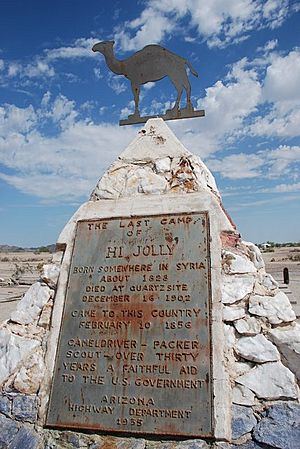Hi Jolly facts for kids
Quick facts for kids
Hi Jolly
Hadji Ali Philip Tedro |
|
|---|---|
 |
|
| Born |
Philip Tedro
c. 1828 İzmir, Aidin Eyalet, Ottoman Empire
|
| Died | December 16, 1902 |
| Nationality | Ottoman, American |
| Occupation | Camel driver (Camel Corps), Miner, Scout |
|
Hi Jolly Monument
|
|
| Location | N end of Cemetery Rd, Quartzsite, Arizona |
|---|---|
| Area | less than one acre |
| Built | 1935 |
| Built by | Edwards, James |
| MPS | Pyramidal Monuments in Arizona MPS |
| NRHP reference No. | 11000054 |
| Added to NRHP | February 28, 2011 |
Hi Jolly or Hadji Ali (Arabic: حاج علي, romanized: Ḥājj ʿAlī; Turkish: Hacı Ali), later known as Philip Tedro, was born around 1828. He was from the Ottoman Empire (which included parts of modern-day Turkey and Syria). In 1856, he became one of the first camel drivers hired by the United States Army. His job was to help with an experiment using camels to carry supplies in the Southwestern United States.
Hi Jolly became very famous during his life in Arizona. Once, he wasn't invited to a German picnic in Los Angeles. To show his displeasure, he drove into the picnic on a yellow cart pulled by two of his pet camels!
Contents
Biography
Early Life and Name
Hi Jolly was born as Philip Tedro in İzmir (which was then called Smyrna) around 1828. His mother was Greek, and his father was a Syrian Christian. As a young man, he became a Muslim. After making a special trip to Mecca (a holy city for Muslims), he was called Hadji Ali. "Hadji" means someone who has completed this important pilgrimage. Later in his life, he started using his birth name, Philip Tedro, again.
Working with Camels
Hadji Ali was a citizen of the Ottoman Empire. He had experience raising and training camels. Before working for the US Army, he served with the French Army in Algiers.
In 1856, the United States Army decided to try something new. They wanted to use camels to carry heavy loads across the "Great American Desert." They hired several men, including Hadji Ali, who were skilled with camels. Eight of these men, including Ali, were from Greece. They arrived in Texas on a ship called the USS Supply.
The US Army bought 33 camels in total from different places like Tunis, Egypt, and Smyrna. Hadji Ali became the main camel driver for this experiment, known as the United States Camel Corps. He led the camels through the dry deserts of the American Southwest.
The Camel Experiment Ends
The camel experiment involved a successful trip from Texas to California and back. However, the project eventually failed. One reason was that the Army's other animals, like donkeys, horses, and mules, were scared of the large camels and often panicked. Also, the American Civil War was starting, and the US government stopped giving money for the camel project.
In 1864, the camels were sold off. Hadji Ali left the US Army in 1870.
Life After the Army
After leaving the Army, Hi Jolly tried to start his own business. He used a few camels he had bought to carry goods between the Colorado River and mining towns. But his business didn't do well, so he let his camels go free in the desert near Gila Bend, Arizona.
In 1880, he became an American citizen. He married Gertrudis Serna in Tucson, Arizona, using his birth name, Philip Tedro. They had two children together. In 1885, the US Army hired him again in Arizona. This time, he worked with mules for General George Crook during the Geronimo campaign.
In his last years, Hi Jolly lived in Quartzsite, Arizona. He worked as a miner and sometimes as a scout for the US government. He passed away in 1902 and was buried in the Quartzsite Cemetery.
Gravesite and Monument
In 1935, the Governor of Arizona, Benjamin Baker Moeur, dedicated a special monument to Hadji Ali and the Camel Corps. This monument is at his gravesite in the Quartzsite Cemetery. It's a pyramid made of local stones with a copper camel on top. This monument is now listed on the National Register of Historic Places and is the most visited spot in Quartzsite.
The plaque on the monument says:
THE LAST CAMP
OF
HI JOLLY
BORN SOMEWHERE IN SYRIA
ABOUT 1828
DIED AT QUARTZITE
DECEMBER 16, 1902
CAME TO THIS COUNTRY
FEBRUARY 10, 1856
CAMELDRIVER – PACKER
SCOUT – OVER THIRTY
YEARS A FAITHFUL AID
TO THE U.S. GOVERNMENT
ARIZONA
HIGHWAY DEPARTMENT
1935
Legacy
Hi Jolly's story has inspired many things:
- A folk song called "Hi Jolly" is based on his adventures.
- The 1954 movie Southwest Passage was largely about the camel experiment.
- The 1976 movie Hawmps! was also loosely based on the camel experiment.
- The 2019 novel Inland by Téa Obreht features a character inspired by Hadji Ali.
- The 1959 children's book Hi Jolly by Jim Kjelgaard tells his story in a fictional way for young readers.
Images for kids




